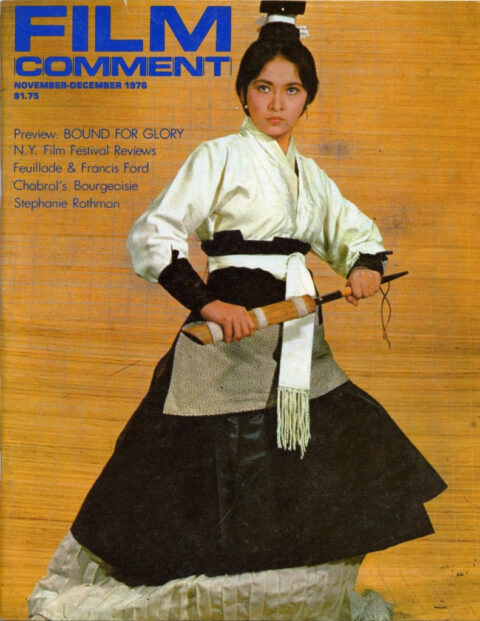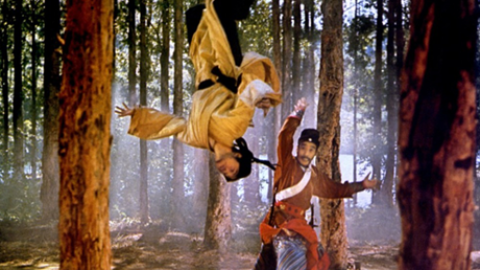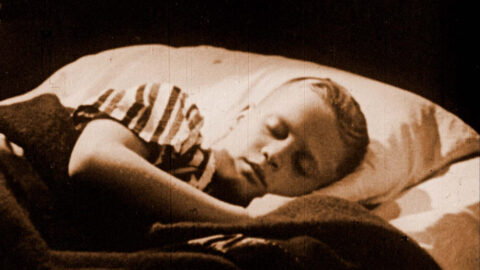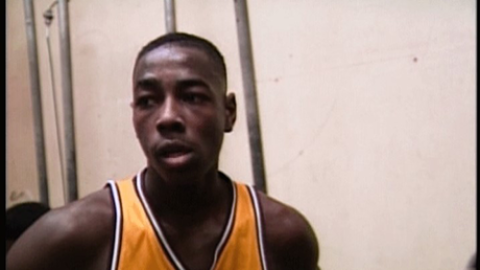I. THE BEST

Ossessione
Ossessione (Luchino Visconti)
In a smudged and spottily bleached 16mm print—apologetically offered to the press by the Festival’s grand vizier, Richard Roud, and then to the general public by the Festival prince of ’76, winsome François Truffaut—Ossessione finally surfaced, by way of epitaph: by hook, crook, or cabalistic summons, to thunder, to trumpet, to shimmer, to triumph. The bewildering cinedustrial political circumstances which have for three decades kept this crucial full-blown masterpiece out of the general American public view are material for incitement to riot. No other cinematic work of comparable stature has ever met a similar fate.
Ossessione is causally—and casually—related to James M. Cain’s The Postman Always Rings Twice. The real antecedents of plot, character, and mode of attack are the gallery of personaggi; from the Attic-Roman-Italian grab-bag: the pagliacci and their ancestors who have mimed the same eternal stories for at least twenty-five centuries. Massimo Girotti is certainly a Pagliaccio, Clara Calamai is a Columbina, Elia Marcuzzo (“lo Spagnolo”) is an Arlecchino the confidant/destroyer, and Juan de Landa is that same stock of older husband/father/master out of Roman comedy.
Ossessione is said to have instituted neo-realism. I Viscontiani nod graciously and go on about their proper business, counseling deferential assent.
The facts are these: every quality of the Visconti genius is present on view in Ossessionethe soil, the tradition: lust, pain, music, compulsive adoration. Ossessione is the fully achieved work of a matured artist, and in the last analysis it heralds nothing but the oracular career of one of the very greatest of the elect in that still small clutch of film masters.
The effective sense and combination of open sky, open road, inn, town—specifically as playing areas and not as backgrounds to “get” on film—displays the narrative-epic collision/surge characteristic of the great silent. Everything (everything in Visconti) comes out of Ossessione (the way, for example, “senso” comes out of “ossessione” in five letters). It is misleading to state that the two lovers plot to murder the husband. In Ossessione, the press of events commands the desperate, almost improvised murder, exactly as in Senso the vengeance of history destroys the Contessa and her dreams. Clara Calamai’s performance in Ossessione, like Alida Valli’s in Senso, is no portrait of a calculating murderess à la Stanwyck, Turner and other famous and fabulous Forties wickeds. It is rather the driven creature, whose “motives” are dictated (as the actress is directed). Massimo Girotti is the pure and sensual uomo throughout, who will take (and make) love in any and every available context: fatherly love from the trusting babbo-marito, sexual treacherous love from the wife, brotherly compare love from the stranger on the train.
Each performance in the film is a perfectly achieved someone, but they are personae first. In terms of the Visconti filmography, it is important to note the fact, because Visconti continued for thirty years to work at this symbolic level no matter the stories, no matter the time. Let us have L’Innocente.

Small Change
L’ARGENT DE POCHE/SMALL CHANGE (François Truffaut)
This year’s Festival opener is that kind of relentlessly affirmative jeu d’esprit about the tremble of younger humans—the passage from so-called latency into early adolescence—about which, like crème de marron, absinthe, le Sacre-Coeur, and the color orange, there are likely to be sharply divided opinions.
“Childhood is not like that and it never was!”
“Mine was.”
“Get lost.”
“Well, it was last night after sitting through L’Argent de Poche.”
Like Maurice Sendak’s kids, this collection of feerique French tots can make a body nervous. As one kindly neighbor did murmur reassuringly, confidentially (a propos French tots): “But they’re not children. They’re all instantly forty!”
François Truffaut—a little over forty, rounding another biographical corner—has confabulated, with Suzanne Schiffmann, a kind of only-just-veristic toy tour in which there are no learning problems, phobic episodes, obsessive-compulsive nose-picking terrors, or wet beds. There is one hilarious “discussion” between two teachers about the mildly vexing problem of exhibition masturbation in the back row, but no evidence of severe personal or social disruption is either indicated or depicted. Instead, the picture purveys a relaxed and relaxing sense of innocence, radiance, hope, and chaste sensuality. Even the shock of the battered boy is no real (eek!) trauma. It has been set up all along by shots of the old witches’ ramshackle house, and when Mama Marie Salope and Grandma Ivrogne are carted off to the hoosegow, the attendant townfolk chorus is right there to reassure.
Coming out of the same cultural-spiritual land as did Zero de Conduite, Forbidden Games, Mouchette, and The Four Hundred Blows (made long ago by an ancestor of François Truffaut), L’Argent de Poche, the fact of it, just goes to show…

The Memory of Justice
THE MEMORY OF JUSTICE (Marcel Ophuls)
A masterpiece, and a triumph as well, apparently, of guts over treachery in the industry: appropriate happenstance. This film tackles thematic material of familiar enormity which has been routinely, politely, civilly neglected for too long. Encountered and restructured by an artist of such patience and methodical urgency as Marcel Ophuls is, this material—the congruence between the routine institutionalized evil of the last two successive political generations of Western mankind—is now a matter of urgent concern in the public record, and demands to be viewed and reviewed. Sentient persons who avoid the task (of sitting and looking for four saturated hours at pity, terror, valor, despair, outrage, courage, and torment,) are to be counseled. Two moments out of the four hours:
Marie-Claude Vaillany-Couturier, now a French senator, recalling her testimony at Nuremberg, given as a witness-survivor of Auschwitz. The footage of the testimony. The freeze at the moment when, leaving the witness stand, she turns to face the authors of her torment and the torment of those millions she represented. The realization, recalled thirty years later, that they looked like rather ordinary men. (“I really don’t know what I expected.”)
Louise and Robert Ransom, two American parents, recalling their son’s death in Vietnam, and re-creating on camera, in interview, the dawning of their realization that that death was futile and brought no honor.
In each of these moments, as again and again throughout the film, Ophuls shows people becoming actors in the noblest sense. They are playing themselves as instruments, carrying themselves beyond themselves, enlarging momentarily, becoming, without a trace of self-regard, significant. It is because Ophuls is pensive rather than aggressive in his approach, and has edited in the small silences between the great statements, that these actors become all mankind. The tormentors and the tormented, equally attended, are here in the flesh as never before since the furious events depicted occurred.

Marquise of O
DIE MARQUISE VON O… (Eric Rohmer)
The laurels, the palm, and the full four golden oranges go to Eric Rohmer and a brilliant cast of German actors for this bold and gorgeous enactment, in which myth, mystery, pathos, and exaltation, and a deal more, vie for one’s attention, win one’s respect, and achieve, by dexterous manipulation, that balance between the profound and the vainglorious which is Romance.
The great triumph is in the realization of the mise-en-scene so much so that the acting itself seems a comment on and a function of the decorous perfection achieved in the telling and the placing. In this respect and in some others—such as the slow pacing, which achieves a dreamlike, processional, or pavanne quality—the film reminds viewers of the luxuries of Bresson. Many of the exquisite gestures executed by Edith Clever as the Marquise (her sitting, standing, walking, reading) are reminiscent of those of Laura Duke Condominas as Guinèvre in Lancelot du Lac. Such cousin-german traits in and among the most radiant works of any kind of art—musical, pictoral, mimetic, or else—can be somewhat eerily reassuring.
The breathless, delicate conclusion (complete with the tag-line: “You would not have seemed a devil had you not first seemed to be an angel.”), followed by Kleist/Rohmer’s petting assurance that All Was Thereafter Well, sends gladdened hearts into a momentary visionary spin.

Dersu Uzala
DERSU UZALA (Akira Kurosawa)
Most technically accomplished. On the acting level, the sustaining of a vital bond between the actors in a two-character film for well over two hours is impressive. Two quite gentle performances, full of seemingly non-acted behavior. More impressive is the interplay of character and situation, figure and ground, when the ground is The Wild. Often enough in the cinematic past, especially in westerns, the sense of a man finding his way through desert places has been beautifully conveyed; but here the intense fury of the Siberian landscape (Weather!) makes viewers into prayers: “Let them make it!” The 70mm pictures and six-track stereophonic sound effects surround the audience, manipulating sensation superbly.

The Middleman
JANA-ARANYA/THE MIDDLEMAN (Satyajit Ray)
A steadily beautiful evocation/depiction of the end of youth and the redefinition of hope. A preview of dimming vision and of death, this film is contemplative, episodic, not especially demanding. It invites a kind of passive attention, largely because its lovingly precise hero (Pradip Mukherjee) seems so passive, so willing, so doleful-chipper—until, in a cumulative effect which suggests the speeding up of both time and emotion, viewers are ushered into the ground of existential dilemma. The suavity of the directorial approach becomes apparent. In black-and-white: a nagging deprivation. Ray should make a film on Ramakrishna; his aesthetic of grievous acceptance, with its hungers for the exemplary, would suit.

Story of Sin
DZIEJE GRZECHU/STORY OF SIN (Walerian Borowczyk)
“What a story! Everythin’ but the bloodhounds…”
Question: Which of the two words in the title means “story” and which “sin”? No matter which or what, sin and story have not been so displayed, or splashed in color, in ages. Grazyna Dlugolecka, a raving beauty, gives a performance in this cockamamie tale the like of which you just don’t find any more. (All those actresses who have been bewailing in recent years the dearth of good roles for women ought to beat a path to Warsaw.) Calculatedly berserk, this heroine suffers it all. She lures men, as they say, straight to their deaths. The cinematic style of Walerian Borowczyk can be described as bold and raunchy, also as overwrought and rapturous. And more. On one viewing, the appetite develops; on a second, quite likely a passion must combust. The lurid religiosity which informs the yarn is irresistible to a temperament tutored in penance, vengeance, and the exaltation of extravagant suffering. The rational are advised.
II: THE REST

Fear of Fear
ANGST VOR DER ANGST/FEAR OF FEAR (Rainer Werner Fassbinder)
Made in 16mm for German television, and declared by its creator to be “no work of art” (during a discussion in which he seemed to be making for the occasion some petulant thrust against such commodity-oriented concepts as completion, achievement, and their attendant risks), this eighty-eight-minute feature item does indeed, as its publicity declares, “loom like melodrama”; whether or not it “stings like truth” is a trickier question. (What is truth?) Angst may taunt, but it does not tell. Still, it’s some show. The acting of the Fassbinder company c. 1975 can be faulted in no single or ensemble situation. The heroine, Margit Carstensen, is even more affecting portraying loss of affect in the onrush of crippling anxiety than was Liv Ullmann facing herself earlier this year. The maniacal hilarity common to deeply disturbed persons leaning over at the very edge of the deep well was depicted with a clinical precision for which one must applaud both actress and director. Slightly similar in its situation to situations currently rampant on a popular American television serial whose heroine has cracked, it is a tantalizingly jagged slice of imitation of life. Even so, although the film stops, it does not end, and the performance of Margit Carstensen registers more like an endlessly tantalizing screen test (“That’s all television is: nothing but auditions”) than a finally accomplished turn.
The music, by Peer Raben, taking its cue from a sequence in which the sweetly fatigued and schlubby husband (Ulrich Faulhaber) is watching the final duet from Der Rosenkavalier on television, develops into a suspicious-sounding pastiche of passages of Strauss’s Die Frau Ohne Shatten. Auf wiederhören?
An exigent exercise. Not a properly sophisticated Festival selection, tho’.

Illustrious Corpses
CADAVERI ECCELLENTI/ILLUSTRIOUS CORPSES (Francesco Rosi)
A wonderful opening, and a stunning closing sequence. In between a lot of instance, eating, smoking, and perplexity. Max Von Sydow contributes another in his line of arbitrary crazies (but what bone structure: so severe, haunted), in this case a compulsive handwashing fascist with fatalistic notions. (This is Sicily, although it’s called Wherever.) Lino Ventura in fine: engaging, sympathetic, and elegant. A fiery little lazzo is offered by Maria Montez’s well-equipped daughter Tina Aumont, playing a prostitute eye-witness. Many die, most nastily, but they are all old, wicked, and judges. Splendid scenes of pompous Sicilian funerals, one with gorgeously plumed black horses. A cat dies, chillingly on camera (?). An interesting effect is achieved when characters remembering, giving evidence, do so on camera by means of black-and-white “television” sequences. The plot thins but political statements abound.
SERAIL (Eduardo de Gregorio)
Leslie Caron cuts up a live lobster with gusto and precision. Corin Redgrave isn’t there. Bulle Ogier and Marie-France Pisier look at one another all the time. The house did it.
DUELLE (Jacques Rivette)
According to its publicity: “A contemporary version of a nonexistent myth.”
Bulle Ogier and Juliet Berto look at one another all the time. A pas de déesses is in progress at ten cents a dance. Worn-out Cocteau notions abound. There are no non-existent myths. The moon did it.

Touch of Zen
SHA-NU/TOUCH OF ZEN (King Hu)
Hours and hours of the most beautiful costumes and scenery anywhere on earth, and delightful tumbles and sailing through the air, as two lovelies, one of each sex, trying to get lost, are found, time and again, but find Shangri-La. Cuckoo, and quite beguiling.

Kings of the Road
IM LAUF DER ZEIT/KINGS OF THE ROAD (Wim Wenders)
The attention of viewers in this film is held by a long catalogue of perfectly balanced shots and by the faces and attitudes of the fine actors: Rüdiger Vogler, Hanns Zischler, Rudolf Schündler, and most especially Marquard Bohm as the man who lost his wife. It is a very long information picture about loneliness and aimless, feckless Existenz. It’s relentlessly probing. (A man shits, another pisses.) It features masturbation, handled comically, as metaphor. It is well made, and it unravels, purposedly. It goes on and on and on. It discusses itself, relentlessly. The discussion is sincere.
“RITES OF PASSAGE” (No names please)
Three short American films, none of them worth viewing. The very beautiful Fionnuala Flanagan plays a nun in one of them, out of (as they say) Joyce Carol Oates. The whacky Shelley Duvall plays a Scott Fitzgerald-inspired bimbo-minx in another. The star of the third (which came first) is a plastic cock of outsize proportions. In the words of a currently active New York moom pix Cassandra: “Big hairy deal!” Yawn to it all.
AI NO CORRIDA/IN THE REALM OF THE SENSES (Nagisa Oshima)
The real thing, and lots of it. And why not. Two beautiful and dedicated performers, Eiko Matsuda and Tatsuya Fuji, explore their realm and ours, coming and going, time and time again. Play it again.

Harlan County U.S.A.
HARLAN COUNTY, U.S.A (Barbara Kopple)
This is aggressive film-making, which prompts its subject-actors into action, somewhat uneasily reminiscent of television on-the-spot reportage, which does not elicit compassion so much as it dictates “appropriate” response. It isn’t well edited; it is raw. It relies entirely too often upon the urgent soundtrack (freshly minted country ballads on topical situations, double-emphasizing points clearly enough made on camera).
Nonetheless and all the same, and whatnot. It is a sloppy album full of talking pictures of important citizens of this country—like for instance Sudie Crusenberr, who smokes a fierce cigarette, as if she’s plugged into the energy in nicotine, even while spitting out her rage for all to hear. She is one among dozens, and the only contact we in the city have had with them has been most likely through viewing the piercing photographs of such as Dorothea Lange and Walker Evans.
Best dream short: Nightlife (Robin Lehman)
Best anxiety-attack short: Organism (Hilary Harris)
Most unnecessary short: Women’s Answers (Agnes Varda)
Happiest short: Sweet Sounds (Richard Robbins, James Ivory, and Ismail Merchant)
Apologies to: Nana (somebody kept talking!) and to Jonas and to Ferdinand.








